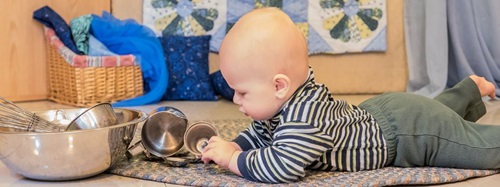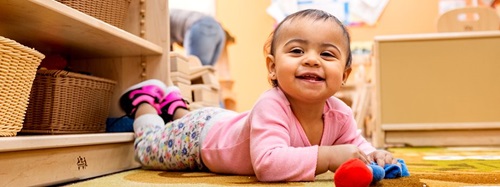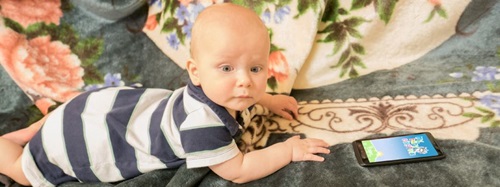Cognitive Development: Thinking and Learning
| May 2024Cognitive development begins at birth when infants start to make sense of the world. Everything is new to them. They’re smelling aromas, tasting foods, hearing sounds, and feeling textures for the first time. With each new experience, the brain makes neural connections. High-quality learning environments provide a variety of ongoing experiences that strengthen these connections in infants. As they are reinforced, the brain is strengthened, and cognitive skills increase. You can offer children from birth to age three experiences that help them develop their cognitive skills. By the time they reach their third birthdays, their ability to think, reason, and solve problems will have grown remarkably, thanks to the exposure to new things you’ve given them.
Cognitive development isn’t a simple, step-by-step process. Young children develop cognitive skills by integrating a variety of underlying skills. These increase alongside developing motor and sensory abilities. For example, infants’ and toddlers’ sensory perceptions and motor activities help them explore and discover the people, things, and events around them.
Jean Piaget believed that children are naturally curious and construct their own learning through trial and error. He viewed cognitive development as a series of stages during which children confront core challenges. He believed that children from birth to age two develop their cognitive skills through sensory exploration and motor development; he called this the sensorimotor stage. During infancy and toddlerhood, children learn through exploration, trial and error, and repetition.
Here’s a look at some of the cognitive skills children learn in their early years.
Cause and Effect
One cognitive skill that infants start to learn very early is cause and effect. Initially, babies seem surprised when a toy moves or makes a noise. They may look at you for reassurance and try to read your response to this surprising event. Their own explorations of cause and effect are simple at first: they swipe at a mobile or shake a rattle, and something happens. When they repeat the action, they may accidentally use a different part of their bodies and produce a different reaction. Through trial and error, they run through a variety of gestures to elicit the desired response. Each of their attempts generates a cognitive connection in the brain. When they become more mobile, they test their theories by making more elaborate cause-and-effect attempts. Does a wooden spoon make the same sound when hit against the floor as when it hits a soft pillow or a plastic toy? Infants learn cause and effect by exploring, pure and simple.
Infants experience cause and effect when they start cooing and babbling, and you coo and babble in return. This reciprocal exchange reinforces their efforts. Cause and effect also fuels infants’ social-emotional development. Cause-and-effect explorations support infants’ perceptual development too. Babies learn about objects through their senses, observing how they work, what sounds they make, how they open and close. Interactive toys with buttons to push and objects that spin or light up reinforce cause and effect and perceptual development.
Children’s problem-solving ability increases when they can experiment with cause and effect by taking things apart, putting them back together, and manipulating objects. As their thinking develops, toddlers become more intentional in their explorations. They discover that they can put toys in a plastic shopping cart, and then they wonder: What else can I put in the cart? And where can I go with it? They might fill up the shopping cart with books and soft toys and wheel it outside to play.
Memory
Piaget observed that children develop mental pictures, or schema, through trial and error, and use this prior knowledge to construct new knowledge. They store this information in their memories, from which it can be retrieved to create more advanced thinking and reasoning. As their attention spans grow, they can retrieve a wider range of information and play with objects longer; this is why they outgrow toys and books and demand more challenging ones. Recognize the growing complexity of a child’s brain and the importance of creating learning environments suited to different developmental stages.
Responsive early learning environments are designed to help children build memory skills. They provide routines and structures that give children opportunities to predict what happens next and that build on existing memories. Share what is going to happen throughout the day with children. In the morning, tell them what the day’s activities will be. Tell the toddlers or twos, “Today, we’re going to play indoors and outdoors. We’ll sing songs and read books. There are puzzles and beads for you to play with too. It’s going to be warm today, so I’m going to put out the water table for those of you who want to use it. I’ll put out yellow paint, paintbrushes, and sponges for you to paint with.” At the end of the day, talk with the children about what they did and what activities will occur tomorrow. Routines like this offer continuity, security, opportunities to follow simple directions, and memory exercises.
Imitation
Long before infants understand themselves as separate people, they can imitate the facial expressions and hand gestures of their parents and caregivers. Children as young as six weeks can imitate the facial expressions of strangers (Meltzoff and Moore 1997). Infants have been observed matching gestures like sticking out their tongues to those of adults. They also self-correct imitative gestures to better match those of adults.
These games that babies play are the foundation of later imitations. All play? Not really: Imitation is how cultural knowledge and family ways get passed down. Infants and toddlers learn their families’ cultures by watching and mimicking people around them. The better they are at imitation, the more thoroughly they are imbued with the cultural values and practices of their families.
Connect imitation to language and vocabulary. Young children happily imitate sounds and repeat the words they hear. You might say, “This is a turtle. Can you say turtle?” They respond by saying the word turtle. You smile and say, “That’s right! Turtle!” Take the time to speak slowly and repeat words. Learning songs and playing with musical instruments increases language development by linking words to imitative gestures. Children learn songs from fingerplays like “Itsy, Bitsy Spider” and by watching and imitating you.
When their cognitive skills improve, children can integrate memory, mental representations, and symbols into imitative gestures and behaviors. In dramatic play, for example, a toddler might mimic a phone conversation he’s observed at home. He imitates his father’s gestures by nodding his head, frowning, and pretending to listen to someone on the phone. He might shake his head “no,” or he might shake his finger at a doll.
Spatial Awareness
Infants become aware of space very early. Spatial awareness is the ability to understand the position of objects in relation to other objects. After their first few months, infants can see more clearly, and they begin to observe how people and things move. They might watch the objects on a mobile flutter and change direction when they touch each other. When they explore objects with their mouths and move or manipulate toys, they learn about spatial and sensory properties. Through trial and error, they learn how items fit together or open and close. As they get older, they may play with puzzle pieces or soft blocks.
Provide child-directed activities, toys, and objects so infants and toddlers can learn about objects in space. Play mats provide them with objects that move and rotate and teach them about spatial awareness. Not only do children learn about the spatial properties of objects, they also learn about their own bodies in space. As they become more mobile, offer them interesting things to crawl through and over, including pillows and climbing tunnels. These objects provide hands-on learning about how their bodies fit, or don’t fit, into spaces. Acknowledge children’s efforts to navigate space and use language and verbal cues to support their growing awareness of space. You might say, “Miguel, I see you crawling through the tunnel. Can you crawl over to the mirror?” When you introduce new toys and objects to them, very young children start to see these things in relation to other objects. They use this awareness to solve problems; for example, how to move around other objects and where a new toy is in relation to other toys. Such experiences teach children how things move and how they are related to other objects.
Connecting Experiences Together
Infants and toddlers constantly build new knowledge, memories, and representations. As their cognitive skills increase, they start to connect these more effectively. The more children experience, the more neural connections they make. Piaget was convinced that young children use their natural curiosity to construct views of the world. High-quality early learning environments stimulate children’s natural curiosity so they want to understand their own experiences.
Responsive caregivers play important roles in helping young children build on existing knowledge and make new connections. Talking and reading to children are key strategies for building their vocabularies and connecting what they observe and experience to words. Use props like puppets to help children make connections to stories and make reading engaging and fun. Activities with music, hand gestures, and body movements encourage children to build connections through sensory experiences. Plan a variety of developmentally appropriate activities that help children connect many kinds of learning.
Following Simple Instructions
As children’s skills in receptive and expressive language and mental representations increase, they can begin to follow simple directions. When you ask them to put their toys on the shelf, they first need to understand clearly what a shelf is and to possess a mental image of placing their toys on that shelf. They learn to follow directions when you help them build on their existing knowledge of directions. Model the task, and walk children through your directions, step by step. Once their memories and mental representations have increased, three-year-olds can follow two- or three-step directions.
You can use picture-and-word charts to help toddlers and twos learn simpler directions. Images help them see what steps they need to follow. For example, a Now-and-Then chart might provide pictures of children eating (now) and going outside to play (then). These charts help children follow simple directions and learn a sequence. As their language skills improve, they can follow directions better. Keep your initial directions simple, and use language that children understand. They need sufficient language skills and cognitive understanding to be successful at following simple directions. These are skills they’ll need in preschool. Be patient while they’re learning to follow directions, and scaffold their learning by modeling the desired behavior.
Final Thoughts
Children develop cognitive skills by exploring the world. Their ability to think, reason, and solve problems increases as they integrate learning across the developmental domains. Neural connections become strengthened when children master concepts of object permanence and mental representation. Two developmental tasks of early childhood are integrating learning and developing complex thinking skills (for example, cause and effect, memory, imitation, spatial and mathematical awareness, connecting experiences, and following simple directions). Offer children opportunities to learn about the world and the creatures and objects in it. (My companion book, Activities for Responsive Caregiving: Infants, Toddlers, and Twos, provides activities that support cognitive development in young children.)
What Caregivers Can Do
- Play games like peekaboo with babies to help them learn object permanence.
-
Talk to children about what they’re seeing and experiencing.
-
Read books with photographs of real objects to children to reinforce their mental images.
-
Provide objects like rattles for infants to play with so they learn about cause and effect.
-
Follow classroom routines and schedules so toddlers and twos can predict the day’s activities.
-
Retell stories and ask children open-ended questions to help them build their memories and mental representations.
-
Provide objects for children to sort and categorize.
- Provide props and objects for children to use in pretend play.
Big Ideas for Caregivers
- Cognitive skills increase when young children build on their prior knowledge.
-
Babies begin to understand object permanence when they learn that people and objects continue to exist even when they cannot be seen, touched, or heard.
- Mental representations help children develop language, cognition, and social skills.
From Foundations of Responsive Caregiving: Infants, Toddlers, and Twos by Jean Barbre, © 2013. Permission granted by Redleaf Press, www.redleafpress.org.










